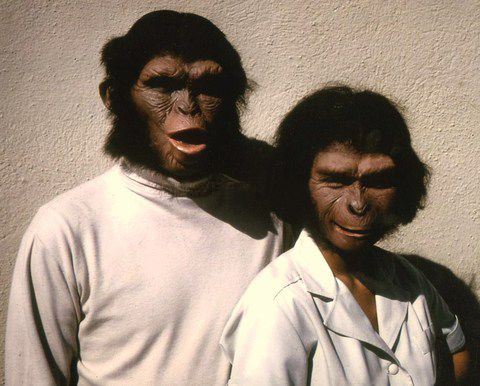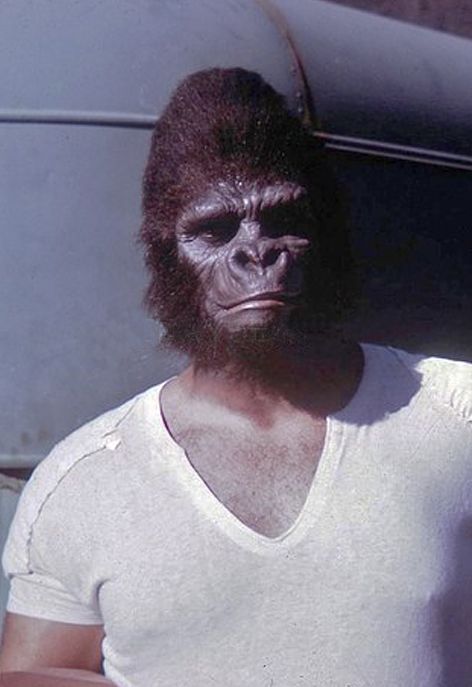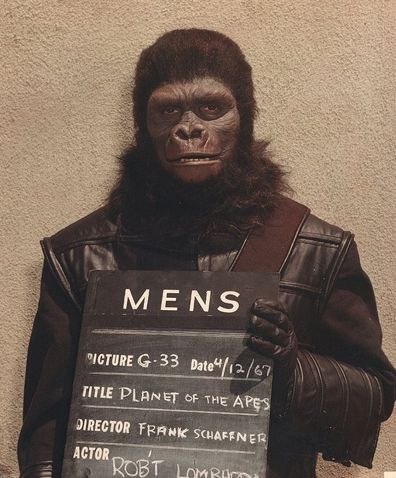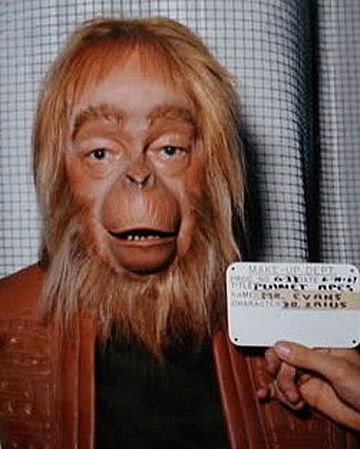 |
|
|
|
|
|
|
|
 |
 |
 |
 |
|
|
 |
 |
 |
|
|
|
|
|
|
 |
 |
 |
Posted: |
Feb 27, 2015 - 9:50 AM
|
|
|
|
By: |
RoryR
(Member)
|
I'm not trying to pigeonhole PLANET OF THE APES into "satire" only, just discussing what motivated the interest of Michael Wilson, Schaffner and Heston. Arthur P. Jacobs envisioned and sold the film as a mass-audience entertainment--a movie for everyone, and that's what it turned out to be. In fact, it's my personal belief that one of the reasons the first PLANET OF THE APES film has stood the test of time is that it's simply great entertainment (if that's all you're after) and if you chose to look at it very close, there's more there than just mere entertainment.
Here is Pauline Kael's review from the February 17th, 1968 "New Yorker." At that time, she was one of the country's toughest film critics and her mostly positive review of PLANET was a surprise to many. I think she nailed what's good about the movie and what's not so good. I don't completely agree with her -- the movie is art on certain levels -- but I don't think in her negative comments she's too far off. PLANET was a lucky production (unlike Jacobs' DOCTOR DOLITTLE), all the planets aligned just right to make it a success. It's not as good as it could have been (and it's my favorite movie, but I still say that), but it was risky material and could have easily been a disaster (for proof of that, I offer the Tim Burton "re-imagining," and to a lesser degree, BENEATH THE PLANET OF THE APES).
"Apes Must Be Remembered, Charlie"
"'Planet of the Apes' is a very entertaining movie, and you'd better go see it quickly, before your friends take the edge off it by telling you all about it. They will, because it has the ingenious kind of plotting people love to talk about. If it were a great picture, it wouldn't need this kind of protection; it's just good enough to be worth the rush.
"Adapted from a novel by Pierre Boulle, 'Planet of the Apes' most closely resembles George Pal's 1960 version of H.G. Wells' 1895 novel 'The Time Machine.' It's also a little like 'Forbidden Planet,' the 1956 science-fiction adaptation of 'The Tempest,' though it's perhaps more cleverly sustained than either of those movies. At times, it has the primitive force of old 'King Kong.' It isn't a difficult or subtle movie; you can just sit back and enjoy it. That should place the genre closely enough, without spoiling the theme or the plot. The writing, by Michael Wilson and Rod Serling, though occasionally bright, is often fancy-ironic in the old school of poetic disillusion. Even more often, it is crude. But the construction is really extraordinary. What seem to be weaknesses or holes in the idea turn out to be perfectly consistent, and sequences that work only at a simple level of parody while you're watching them turn out to be really funny when the total structure is revealed. You're too busy for much disbelief anyway; the timing of each action or revelation is right on the button. The audience is rushed along with the hero, who keeps going as fact as possible to avoid being castrated or lobotomized. The picture is an enormous, many-layered black joke on the hero and the audience, and part of the joke is the use of Charlton Heston as the hero. I don't think the movie could have been so forceful or so funny with anyone else. Physically, Heston, with his perfect, lean-hipped, powerful body, is a god-like hero; built for strength, he's an archetype of what makes Americans win. He doesn't play a nice guy; he's harsh and hostile, self-centered and hot-tempered. Yet we don't hate him, because he's so magnetically strong; he represents American power -- the physical attraction and admiration one feels toward the beauty of strength as well as the moral revulsion one feels toward the ugliness of violence. And he has the profile of an eagle. Franklin J. Schaffner, who directed 'Planet of the Apes,' uses the Heston of the preposterous but enjoyable 'The Naked Jungle' -- the man who is so absurdly a movie-star myth. He is the perfect American Adam to work off some American guilt feelings or self-hatred on, and this is part of what makes this new violent fantasy so successful as comedy.
"'Planet of the Apes' is one of the best science-fiction fantasies ever to come out of Hollywood. That doesn't mean it's art. It is not conceived in terms of vision or mystery or beauty. Science-fiction fantasy is a peculiar genre; it doesn't seem to result in much literary art, either. This movie is efficient and craftsmanlike; it's conceived and carried out for maximum popular appeal, though with a cautionary message, and with some attempts to score little points against various forms of establishment thinking. These swifties are not Swift, and the movie's posture of superiority is somewhat embarrassing. Brechtian pedagogy doesn't work in Brecht, and it doesn't work here, either. At best, this is a slick commercial picture, with it's elements carefully engineered -- pretty girl (who unfortunately doesn't seem to have had acting training), comic reliefs, thrills, chases -- but when expensive Hollywood engineering works, as it rarely does anymore, the results can be impressive. Schaffner has thought out the action in terms of the wide screen, and he uses space and distance dramatically. Leon Shamroy's excellent color photography helps to make the vast exteriors (shot in Utah and Arizona) an integral part of the meaning. The editing, though, is somewhat distracting; several times there is a cut and then a view of what we have already seen from a different angle or from much higher up. The effect is both static (we don't seem to be getting anywhere) and overemphatic (we are conscious of being told to look at the same thing another way).
"The makeup (there is said to be a million dollars' worth) and the costuming of the actors playing the apes are rather witty, and the apes have a wonderful nervous, hoping walk. The best little hopper is Kim Hunter, as an ape lady doctor; she somehow manages to give a better performance in this makeup than she has ever given on the screen before."
 |
|
|
|
|
|
|
|
|
|
|
|
|
|
|
|
|
|
|
|
|
|
|
|
|
|
 |
 |
 |
Posted: |
Mar 1, 2015 - 9:33 AM
|
|
|
|
By: |
RoryR
(Member)
|
Have to be honest with you here and say I have NEVER heard this explanation officially and I'm pretty well versed in the original Apes movies and have been for years.
Can you point me to your source for Chambers saying his make up was designed to be next-generation apes?
Well, over the years, and remember PLANET has been my favorite movie since I first saw it when I was eight in April 1968, I've read many things and collected as many articles and clippings on the subject that I can find. There have been very few things written about the "evolution" of the production of the first APES movie beyond studio puff pieces. There have been a few books, but they are of varying quality and depth. Many of these things I've read once and put away, sometimes decades ago, so my memory of what's been said and who's said it is flawed, but as to this subject, I've been looking into what I have and have found that in fact the issue is kind of muddy. Many of the people involved are dead and can no longer clarify things, and, as you'll soon see, others still alive (at least at the time the articles were written) sometimes seem to be taking more credit than they actually deserve. Having said all that, I'll now tell you what I know, and what I assume.
The best article I've ever come across on the creation of the APES makeup (though it's still not as in depth as I'd like) is one by a Scott Essman in the September 1997 issue of Cinefex Issue 71, titled "John Chambers: Maestro of Makeup." This is some of what it says and it starts in 1966:
"Later that same year, another assignment -- arriving by way of Tom Burman, then a makeup apprentice at Twentieth Century Fox -- would prove to be the definitive project of Chambers' career. "There was a big show coming," recalled Burman, "and department head Ben Nye was going to retire if they went ahead with it. Fox had done some extensive tests that didn't work, and I had heard that the producers wanted the men who had done The List of Adrian Messenger. So I spoke up, and said, 'The person who really innovated that work is John Chambers.' John picked up the screenplay; and the following Monday he came in, called me over and said, 'Tommy, you're with me on this -- and I'm going to win an Academy Award.'"
Now I need to stop and say that I have a recollection of reading, years ago, an article about or interview with John Chambers in which he said something to the effect that he read the script first (which confirms the above) and saw that the ape characters were not animals, but rather men, actually men-apes or ape-men. I can't find this article and therefore I don't trust the acuracy of my memory. I know I read that someplace, but am I sure it was Chambers who said it? I can't prove it. Anyway, to continue with the Cinefex article:
"In January 1967 -- with makeup artist and close friend Dan Striepeke -- Chambers began work on Planet of the Apes. Tasked with designing, creating and applying scores of convincing ape makeups for a cast of hundreds, Chambers would oversee a huge crew, delegating authority in the supportive manner that was to become his trademark. "I got the chance to dabble in everything," said Burman, who served as an apprentice on the picture. One of Burman's first assignments was to sculpt the initial ape concepts. "The original sculptures were much more authentically apelike."
Now, I'm going to stop again to show you what he's talking about, at least as far as the chimpanzee makeup goes, and here it is:

The final version of the chimpanzees would feature light-skinned faces. Light skinned chimps are either babies or juveniles, chimp faces darken as they mature, so the light-skinned chimpanzee characters in the original APES series, including what Rick Baker did in the remake, are essentially "adult" baby chimps.
And here's an early gorilla design. Note the attempt at an adult male "sagittal crest" on the top of the gorilla's head (something Rick Baker would do with his ape makeups in the remake), also they haven't included the "fur collar" that would eliminate the human neck, since gorillas have little if any necks.

Here's a photo of what would become the final gorilla makeup (with better wigs). Note the lack of a sagittal crest. Real world gorillas have sagittal crests in order to anchor the large jaw muscles they need in order to chew the tough plants they eat. I would assume the gorillas in the movie no longer needed large jaw muscles.

Getting back to the article in Cinefex, Burman then says, "Due to my lack of sculpting skills at the time, my later sculptures looked a little more humanoid. The producers saw them and eventually went in that direction."
Now, in the years since I read that article I've thought it was Chambers that was quoted saying that, but it was Burman. But now I will quote Chambers, this time from the Joe Russo/Larry Landsman book "Planet of the Apes Revisited." (I know Russo and that his interviews were mostly done by phone over thirty years ago.)
Chambers: "Our final concept involved our modifying the simian wrinkles so they did not appear too grotesgue. The simian nose was somewhat modified by making it a little pleasanter, softer and longer. By doing this, we were able to change the ape nostrils a little. On apes they look like big slits in the middle of the face. Since our actors would be on the screen in this makeup through all the film, we felt they should look a little more attractive. It wasn't that we wanted to beautify it, but also we did not want it so grotesque that it would distract from the story."
So it would seem that the effort to "soften" the appearence of real apes as opposed to those in the film was a combined decision between the makeup artists and the wishes of the producers (Arthur P. Jacobs, Mort Abrahams and others, and I would include Frank Schaffner, since the director is the one who's in artistic control of the picture.). I contend that while there may not be any definitive statement from anyone involved in the production of PLANET OF THE APES that they were going for an "evolved simian" appearence to the characters, that's what they ended up doing anyway even if only by accident. Perhaps the book that's forthcoming from Chromaparadise, with all the internal APJAC memos, will throw more light on just what the producers were thinking in their "evolution" of what the final appearance of the apes would be, but then there's the fact that the apes in the film are supposed to be intelligent simians. Well, a modern ape's skull can not house a human brain, it isn't large enough, and you're not going to get a humanly intelligent ape unless there's an evolution in the size of its cranium. They're also not going to be able to talk unless there's an evolution in the structure of their thoats. So, logically the apes of PLANET OF THE APES have to be evolved apes. (The series would acknowledge this itself later in ESCAPE and CONQUEST when it would directly mention "primitive apes.") Note also that in the real world adult orangutans have cheek pads and there was no attempt to reproduce this in the production of the original makeups. (Rick Baker, though, wouldn't ignore it in the remake.)

I'll finish with how these things can, after so many years, get kind of murky. This is also from "Planet of the Apes Revisited":
"Regarding the makeup, [Mort] Abrahams emphasizes one particular point, and a rather surprising one at that: 'The truth is that the actual groundwork, the labor, the 'hands-on' work, was Dan Streipeke. John Chambers was more of a concept man.'
John Chambers strongly disagrees with this viewpoint. 'Dan is an exceptional makeup artist,' he says. 'When we were doing the first film, I had my hands full just keeping an organization of people physically working. And then working myself, creatively working, sculpting. All the major principle sculpture was done by myself -- for all those principles. No one else touched it. The subordinate sculpture was done by artists that I picked. Copies were made later. But all the original concepts were sculpted by myself. Purposely, so no one twenty or thirty years later would say, 'I created this.' And I've documented it, too -- while I'm alive, because several people have got me buried already and are taking credit. But I did it."
Yes, John Chambers, you did.

Well, I can't get the YouTube to display, so I'll just provide the link:
https://www.youtube.com/watch?v=7LCNNNGane4
 |
|
|
|
|
|
 |
 |
 |
Posted: |
Mar 1, 2015 - 10:33 AM
|
|
|
|
By: |
RoryR
(Member)
|
I didn't remember the timeline. Obviously 2000 years is nothing in evolutionary terms. My other explanation, (and it just has to work for me!) is that nuclear fallout and radiation muted the apes into their more human like form. It's an interesting subject I never thought of before.
I intellectually matured past this concept during my teenage years. I just don't buy that nuclear radiation alone can create whatever is needed in any Science Fiction scenario, from super apes to giant ants to telepathic human mutants. Radiation just doesn't actually get it done, it just mostly kills. That kind of thinking belongs to the 1950's and before. No, a more enlightened view is that a future earth, only two thousand years hence, with advanced apes on it, would have to be the product of human genetic re-engineering, and this is exactly what was proposed in not just the otherwise lamentable Burton remake, but the much more intelligent, though still scientifically implausible, RISE OF THE PLANET OF THE APES.
 |
|
|
|
|
|
 |
 |
 |
Posted: |
Mar 1, 2015 - 8:01 PM
|
|
|
|
By: |
Solium
(Member)
|
I didn't remember the timeline. Obviously 2000 years is nothing in evolutionary terms. My other explanation, (and it just has to work for me!) is that nuclear fallout and radiation muted the apes into their more human like form. It's an interesting subject I never thought of before.
I intellectually matured past this concept during my teenage years. I just don't buy that nuclear radiation alone can create whatever is needed in any Science Fiction scenario, from super apes to giant ants to telepathic human mutants. Radiation just doesn't actually get it done, it just mostly kills. That kind of thinking belongs to the 1950's and before. No, a more enlightened view is that a future earth, only two thousand years hence, with advanced apes on it, would have to be the product of human genetic re-engineering, and this is exactly what was proposed in not just the otherwise lamentable Burton remake, but the much more intelligent, though still scientifically implausible, RISE OF THE PLANET OF THE APES.
Honestly, 2000 years or several million years it didn't resonate with me because I was so young at the time. I just thought they looked more humanoid because of evolution. Your correct radiation either kills or deforms.
Anyway your post above was very interesting. I know very little behind the scenes stuff about the Apes films.
 |
|
|
|
|
|
|
|
|
|
 |
 |
 |
Posted: |
Mar 2, 2015 - 11:27 AM
|
|
|
|
By: |
Solium
(Member)
|
I know very little behind the scenes stuff about the Apes films.
That's because APES has always been a "minor cult." Despite a five-film series, and two TV shows and lots of merchandise (mostly crap), POTA was never and will never be a "major cult" on the level of STAR WARS or STAR TREK. The recent book about the franchise, co-authored by Jeff Bond, was a nice thing, but it couldn't support the scope needed to get really wonky with a lot of behind-the-scenes detail about each production. For the average reader, the eyes would glaze over. I don't know who ChromaParadise is or if this book he's saying he's writing about APJAC Productions is really going to happen -- and I'm not trying to be negative, but there's always that possibility -- but it promises to through more light on the unknown but it's still not going to be the kind of thing you get about some other much more popular SF film franchises.
True, Apes isn't anywhere near as big as Star Trek or Star Wars. It's also a unique beast in itself for being anthropomorphic based. Which is a niche within a niche when it comes to sci fi and fantasy. I would also add, both Trek and Wars had an organic growth because of a wanting fan base. Apes was more of a mechanical driven franchise by the studio.
 |
|
|
|
|
|
|
|
|
|
|
|
 |
 |
 |
|
|
 |
 |
 |
| |
|
|
|
 |
|
 |
|
|
|


